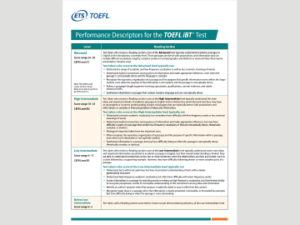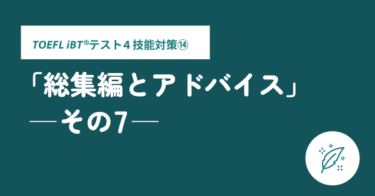
※TOEFL iBT®テストは2019年にテスト内容の一部が変更となりました。現在のテストと異なる内容が含まれておりますが、基本的な考え方や学習方法に違いはないため掲載しています。詳細はこちらをご確認ください。
Readingセクションにおけるパッセージ(本文)で、最後に出題されるのが
- ・Prose Summary Questions(要約問題)
- ・Fill in a Table Questions(表完成問題)
のどちらかです。詳細に統計をとったわけではありませんが、私個人の経験からすると出題頻度としてはProse Summary Questionsの方が高いようです。よってまずはこちらで確実にスコアをとれるように学習していきましょう。
高難易度問題③ Prose Summary Questions(要約問題)-概要
- ・パッセージに対する要約を完成させなさいという問題です
- ・設問の最後(Q13またはQ14)に出題されます
- ・選択肢は6つあり、それぞれが1センテンスとなっています。そのうち要約として相応しい3つのセンテンスを選んで、空欄の四角の中にドラッグ&ドロップします
- ・残り3つは要約としては不適切ということになります
- ・空欄の四角の上にIntroductory sentenceと呼ばれる一文が太字で表示されています。これはもともと要約が4センテンスあり、そのうちの1つがすでに解答されている、と考えると良いでしょう
- ・表の中では順番は関係ありません
- ・配点は2点です。Summaryが3つとも合っていれば2点、2つなら1点、1つだけの場合は0点です
高難易度問題③ Prose Summary Questions(要約問題)-解き方の手順と注意点
- 解答には最低3~4分程かかると考えてください。つまりそれまでの問題を16分程度で終える必要があります
- Summary Questionsにたどり着くまでに12問解いているわけですから、本文の全体をほぼ読み終えているわけです。しかしあやふやな印象のままでsummaryを作るのは危険です
- 1と2を踏まえて、パッセージのタイトルと、主旨をもう一度掴むべく全体を見直しましょう。画面右上にあるView Passageボタンを押すと、設問画面から切り替わりパッセージ全体を読み返すことができます
- 上記概要で紹介したintroductory sentenceを読み、参考としてヒントを得ましょう
- 本文とintroductory sentenceを参照しつつ、選択肢を分析する作業にかかります
注意点
要約を完成するからには、何が要約として適切なのか、そうでないのかを知っている必要があります。
Summaryになれる選択肢
・全体の重要なアイディアが含まれる
・比較、プロセス、問題と解決など、本文の大きな構成が含まれる
・本文中、ある程度の量(行数など)に渡って説明されているアイディアが含まれている
Summaryになれない選択肢
・本文中に記述がないアイディアが含まれる
・本文中に記述はあるが、一部においてのみしかないアイディアや事例
・本文の主旨に反する内容を含む
高難易度問題③ Prose Summary Questions(要約問題)-例題
それでは準備はよいでしょうか?読者の皆さんには以下の問題にトライしていただきます。初見のパッセージかもしれませんし、Q1 – Q12までを解いていないわけですから、じっくり時間をかけて本文を何回も読んでからで構いません。
Electricity from Wind
¶1 Since 1980, the use of wind to produce electricity has been growing rapidly. In 1994 there were nearly 20,000 wind turbines worldwide, most grouped in clusters called wind farms that collectively produced 3,000 megawatts of electricity. Most were in Denmark (which got 3 percent of its electricity from wind turbines) and California (where 17,000 machines produced 1 percent of the state’s electricity, enough to meet the residential needs of a city as large as San Francisco). In principle, all the power needs of the United States could be provided by exploiting the wind potential of just three states — North Dakota, South Dakota, and Texas.
¶2 Large wind farms can be built in six months to a year and then easily expanded as needed. With a moderate to fairly high net energy yield, these systems emit no heat-trapping carbon dioxide or other air pollutants and need no water for cooling; manufacturing them produces little water pollution. The land under wind turbines can be used for grazing cattle and other purposes, and leasing land for wind turbines can provide extra income for farmers and ranchers.
¶3 Wind power has a significant cost advantage over nuclear power and has become competitive with coal-fired power plants in many places. With new technological advances and mass production, projected cost declines should make wind power one of the world’s cheapest ways to produce electricity. In the long run, electricity from large wind farms in remote areas might be used to make hydrogen gas from water during periods when there is less than peak demand for electricity. The hydrogen gas could then be fed into a storage system and used to generate electricity when additional or backup power is needed.
¶4 Wind power is most economical in areas with steady winds. In areas where the wind dies down, backup electricity from a utility company or from an energy storage system becomes necessary. Backup power could also be provided by linking wind farms with a solar cell, with conventional or pumped-storage hydropower, or with efficient natural-gas-burning turbines. Some drawbacks to wind farms include visual pollution and noise, although these can be overcome by improving their design and locating them in isolated areas.
¶5 Large wind farms might also interfere with the flight patterns of migratory birds in certain areas, and they have killed large birds of prey (especially hawks, falcons, and eagles) that prefer to hunt along the same ridge lines that are ideal for wind turbines. The killing of birds of prey by wind turbines has pitted environmentalists who champion wildlife protection against environmentalists who promote renewable wind energy. Researchers are evaluating how serious this problem is and hope to find ways to eliminate or sharply reduce this problem. Some analysts also contend that the number of birds killed by wind turbines is dwarfed by birds killed by other human-related sources and by the potential loss of entire bird species from possible global warming. Recorded deaths of birds of prey and other birds in wind farms in the United States currently amount to no more than 300 per year. By contrast, in the United States an estimated 97 million birds are killed each year when they collide with buildings made of plate glass, 57 million are killed on highways each year; at least 3.8 million die annually from pollution and poisoning; and millions of birds are electrocuted each year by transmission and distribution lines carrying power produced by nuclear and coal power plants.
¶6 The technology is in place for a major expansion of wind power worldwide. Wind power is a virtually unlimited source of energy at favorable sites, and even excluding environmentally sensitive areas, the global potential of wind power is much higher than the current world electricity use. In theory, Argentina, Canada, Chile, China, Russia, and the United Kingdom could use wind to meet all of their energy needs. Wind power experts project that by the middle of the twenty-first century wind power could supply more than 10 percent of the world’s electricity and 10-25 percent of the electricity used in the United States.
14. Directions: An introductory sentence for a brief summary of the passage is provided below. Complete the summary by selecting the THREE answer choices that express the most important ideas in the passage. Some sentences do not belong in the summary because they express ideas that are not presented in the passage or are minor ideas in the passage. This question is worth 2 points.
In the future, wind power is likely to become a major source of the world’s energy supply.
●
●
Answer Choices | |
| 1. Wind farms have already produced sufficient amounts of electricity to suggest that wind power could become an important source of electric power. | 4. Responding to environmentalists concerned about birds killed by wind turbines, analysts point to other human developments that are even more dangerous to birds. |
| 2. Smaller countries, which use less electricity than large countries, are especially suited to use wind power to meet all their energy needs. | 5. The wind energy produced by just a small number of states could supply all of the power needs of the United States. |
| 3. Although wind power is not economical in areas with steady winds, alternative wind sources can be used to simulate wind power. | 6. Wind power has several advantages, such as low pollution and projected cost declines, compared to other energy sources. |
(source: ETS, TOEFL® Practice Test Set 3, Electricity from Wind)
<解答・解説>
本文の全体的な流れ、そしてintroductory sentenceからも風力発電について概ね「ポジティブ・楽観的」なトーンになっているのがわかると思います。
では選択肢の分析を行いましょう。
- …wind power…important source of electric power.
― ○ 本文の内容・トーンと合っています。 - Smaller countries…especially suited
― × 国の大小による比較はしていません。 - …not economical in areas with steady winds
― × 第4段落の内容と逆になっています。 - human developments…more dangerous
― ○ 第5段落で詳細に説明されている内容です。 - …a small number of states…all the power needs of the US
― × 第1段落の1センテンスに記述があるのみなので、間違ってはいませんが要約としては不適切です。 - Wind power…advantages
― ○ これも本文の内容・トーンと合っています。
ということで正解は1、4、6でした。いかがでしたでしょうか?是非とも時間をかけて本文と選択肢の見直しを行ってください。
それでは今回はここまでにしましょう。また次回お会いしましょう!

五十峰 聖先生
桜美林大学 芸術文化学群 特任講師
ETS Authorized Propell® Facilitator
ETS TOEFL ITP® Teacher Development Workshop Facilitator
上記は掲載時の情報です。予めご了承ください。最新情報は関連のWebページよりご確認ください。
学習サポート・関連情報
★テスト受験までの8週間サポート★

初めてTOEFL iBT®テストを受験される方のうち、次の対象者には週1回✖️8週間 の受験支援メール配信とTOEFL iBT® Test Prep Plannerの無料配送を行っています。
対策塾などに通わず、独学で勉強されている皆さん、「TOEFL®テストの勉強は孤独・心配・不安…」と感じていませんか?
ETS Japanは、8週間サポートを通じて、学習計画の立て方や、勉強に必要な情報の探し方をお手伝いします。目標スコア獲得に向けて受験日まで一緒に進んでいきましょう!
★公式教材を利用して目標スコアを目指そう★

目標スコア別に公式教材を利用した学習法を教材ショップのスタッフがご提案。学習の目安や各教材ごとの学習方法など、ぜひ参考にしてください。

Performance Descriptors for the TOEFL iBT® test
各セクションは0~30のスコアで評価され、そのスコアに応じて4または5段階のレベルに分けられます。このレベルはTOEFL iBT®テストにおけるCEFR levelを反映しています。

TOEFL iBT®テスト スコアガイド(Speaking)
Speakingセクションの採点基準です。上記の「Performance Descriptors for the TOEFL iBT®test」と併せてご活用ください。
SpeakingはETSが公表しているスコア基準表に沿って採点されます。採点基準はIndependent Task用・Integrated Task用にそれぞれ作成されており、Delivery(話し方)/Language Use(語彙の使い方)/Topic Development(トピックの展開)の大きく3つのポイントに分かれています。

TOEFL iBT®テスト スコアガイド(Writing)
Writingセクションの採点基準です。上記の「Performance Descriptors for the TOEFL iBT® test」と併せてご活用ください。
Writingに関してもETSが公表しているスコア基準表に沿って採点されます。採点基準はIndependent Task用・Integrated Task用にそれぞれ作成されています。

英語圏の大学・機関だけでなく、世界の大学・機関で、公式スコアとして留学や就活などに活用されています。コンピュータ上で受験し、スピーキングは回答音声をマイクを通して録音、ライティングはタイピングで回答します。

自宅受験TOEFL® Essentials™テスト
2021年から自宅受験型の新しいテストとしてリリースされました。約90分の試験時間、短い即答式タスクが特徴のアダプティブ方式の導入されています。公式スコアとして留学や就活などにご利用いただけます。

TOEFL ITP®テストプログラムは、学校・企業等でご実施いただける団体向けTOEFL®テストプログラムです。団体の都合に合わせて試験日、会場の設定を行うことができます。全国500以上の団体、約22万人以上の方々にご利用いただいています。










